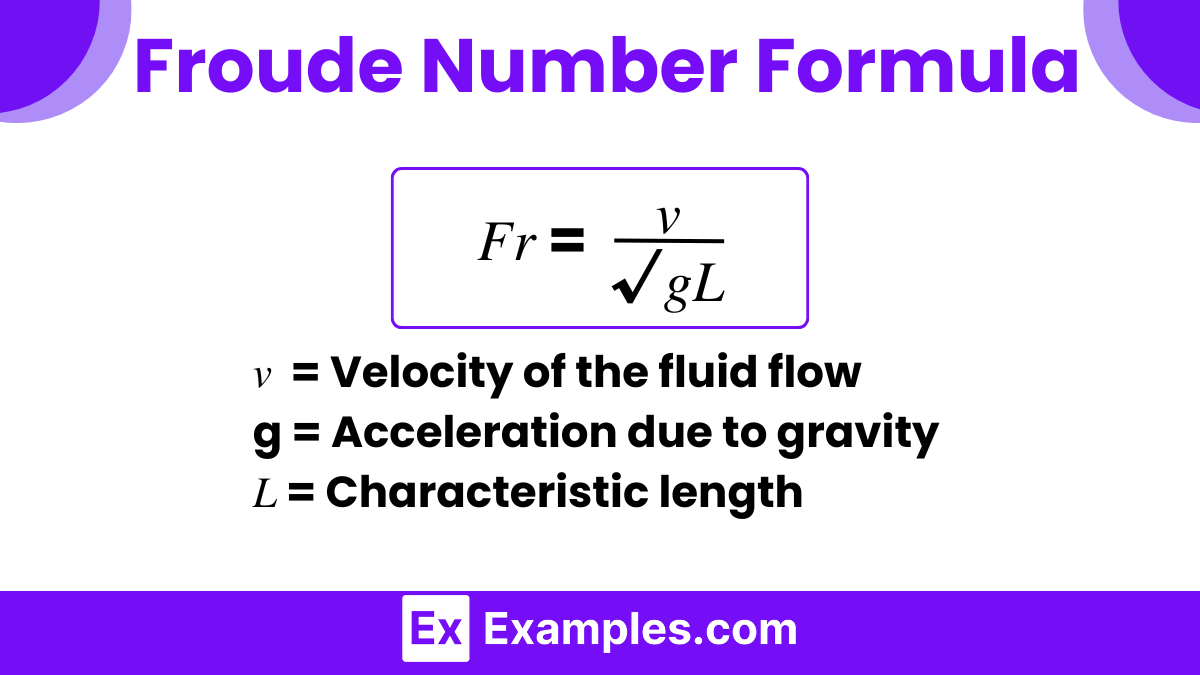What is the Froude number used to describe in fluid dynamics?
The ratio of inertial to viscous forces
The ratio of inertial to gravitational forces
The ratio of viscous to gravitational forces
The ratio of pressure to inertial forces


The Froude Number Formula is a fundamental concept in the field of physics, specifically within the study of fluid dynamics. This formula is instrumental in comparing the ratio of inertial forces to gravitational forces in fluid motion scenarios. It was developed by the English engineer William Froude, who discovered it in the 19th century. Froude’s work was primarily aimed at improving ship design and understanding how objects, such as ship hulls, interact with water at various speeds. Derivation of the Froude Number Formula starts by examining the forces that influence a body moving through a fluid. The formula is
This formula helps determine whether the flow regime in a particular situation is dominated by gravitational forces or by the inertia of the moving fluid. By using the Froude number, physicists and engineers can predict phenomena like wave formation and fluid flow behavior around objects.
This formula has become a cornerstone in the analysis and design of various engineering projects, especially in scenarios where understanding the interaction between fluid and gravitational forces is crucial. It provides a clear, quantitative measure that helps guide decisions in complex fluid dynamic environments.
Problem: A boat is traveling at a speed of 8 meters per second. The characteristic length of the boat, typically the length of the waterline, is 20 meters. Calculate the Froude number for the boat and determine the type of flow around the boat. Assume gravity 𝑔=9.81 m/s².
Solution:
1) Identify the known values:
Velocity 𝑣=8 m/s
Characteristic length 𝐿=20 m
Acceleration due to gravity 𝑔=9.81 m/s²
2) Apply the Froude number formula:𝐹𝑟=𝑣 / √𝑔𝐿.
𝐹𝑟=8 / √9.81×20
𝐹𝑟 = 8 / √196.2 ≈ 814.01 ≈ 0.571.
3) Interpretation: A Froude number of 0.571 suggests that the flow is sub critical, which means that the gravitational effects are more significant than the inertial effects. This is typical for boats moving at moderate speeds.
Problem: Determine the speed a boat must travel to achieve a Froude number of 0.8 if the characteristic length of the boat is 30 meters.
Solution:
1) Identify the known values:
Froude number 𝐹𝑟=0.8
Characteristic length 𝐿=30 m
Acceleration due to gravity 𝑔=9.81 m/s2
2) Rearrange the Froude number formula to solve for velocity 𝑣: 𝑣=𝐹𝑟 × √𝑔𝐿
𝑣 = 0.8 × √9.81×30
𝑣 = 0.8 × √294.3 ≈ 0.8 × 17.15 ≈ 13.72 m/s
Conclusion: The boat needs to travel at approximately 13.72 meters per second to achieve a Froude number of 0.8. This speed is in the transitional range, nearing the critical point where inertial forces begin to match gravitational forces.
The Froude number indicates the relationship between a fluid’s inertial and gravitational forces, essential for analyzing fluid dynamics.
The Froude number is calculated by using the formula 𝐹𝑟 = 𝑣 / √𝑔𝐿. Here, v is velocity, 𝑔 gravity, and 𝐿 characteristic length.
A strong hydraulic jump occurs at a Froude number greater than 1, indicating supercritical flow conditions before the jump.
Text prompt
Add Tone
10 Examples of Public speaking
20 Examples of Gas lighting
What is the Froude number used to describe in fluid dynamics?
The ratio of inertial to viscous forces
The ratio of inertial to gravitational forces
The ratio of viscous to gravitational forces
The ratio of pressure to inertial forces
In the Froude number formula Fr = v/√gL, what does v represent?
Gravitational acceleration
Characteristic length
Fluid velocity
Density of the fluid
What does the term √gL in the Froude number formula represent?
Acceleration due to gravity
Characteristic length
Inertial force
Wave speed
What physical phenomena is the Froude number particularly useful for analyzing?
Turbulence in air
Viscous flows in pipes
Ship hull design and open channel flow
Pressure drops in closed systems
If the Froude number is less than 1, what type of flow is typically indicated?
Supercritical flow
Subcritical flow
Critical flow
Turbulent flow
What does a Froude number greater than 1 signify?
Laminar flow
Subcritical flow
Supercritical flow
Transitional flow
At a Froude number of exactly 1, what is the flow condition called?
Subcritical
Supercritical
Critical
Transitional
Which of the following conditions is likely to increase the Froude number in an open channel flow?
Increasing the depth of the water
Increasing the slope of the channel
Decreasing the velocity of the flow
Decreasing the gravitational constant
Why is the Froude number important in ship design?
It determines the ship's buoyancy
It predicts the ship's resistance to sinking
It helps predict wave-making resistance
It calculates the ship's maximum speed
In the context of river engineering, what does a high Froude number indicate?
The river has a slow flow
The river has a steep gradient
The river has a high water volume
The river has a high sediment load
Before you leave, take our quick quiz to enhance your learning!

